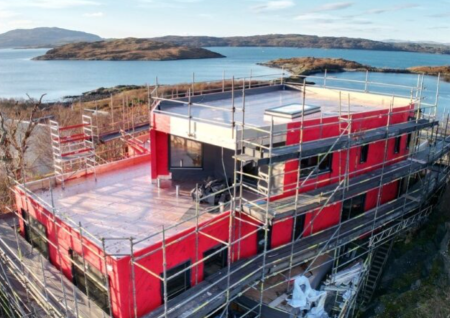Showhome magazine identifies which are the most common types of construction insurance for developments, why you should have it and when to start looking
Construction insurance is an overall name given to various types of insurance policies that provide coverage for property damage, third-party injuries or damage claims. But if you are new to building contractors insurance, or the construction industry in general, you are probably finding the world of construction insurance a tad confusing. You should always consider your own risk profile and accordingly seek expert guidance from a specialist broker or equivalent qualified advisor. “What insurance should my builder have? What is Construction Liability insurance? And who pays for the policy?”
To give you peace of mind and to make sure you don’t get lost in a minefield of acronyms, we have put together this quick guide to builders insurances in the UK. Helping you find out what insurance services you need and when you need it. This guide summarises the main types of insurance you need to be aware of for your development project.
Public Liability Insurance
What is Public Liability insurance?
Public Liability (PL) insurance is a common type of business insurance that protects against liabilities for injury to third parties (non-employees) or their property.
Who needs Public Liability insurance?
If you work near other people and/or their property, which is basically anyone in construction, you should consider having PL insurance. This will ensure you are covered against any potential claims for damage to the person and/or their property. PL insurance should be renewed every 12 months.
Product Liability Insurance
What is Product Liability insurance?
Product Liability insurance protects against liability for injury to people or property arising from the products you supply, manufacture or even import.
Who needs Product Liability insurance?
If you supply, manufacture, adapt or import any products used by other people then you should consider this cover.
Employer Liability Insurance
What is Employer Liability insurance?
Employer Liability (EL) insurance protects against liabilities to employers for injuries or illness.
Who needs Employer Liability insurance?
If you are an employer, EL insurance is compulsory. You may also want to look into EL insurance if you are building your own home. Injury to volunteers or sub-contractors could spark a claim against you as an ‘employer’.
Contractors All Risk Insurance
What is Contractor All Risk insurance?
Contractors All Risk (C.A.R.) insurance protects against physical damage to works and site materials that you were contracted to undertake. These types of losses are normally excluded under a regular Public Liability policy although they may be sold together.
How does Contractor All Risk insurance work?
If a contractor causes damage to a part of the property they were contracted to work on, standard PL insurance may not provide full coverage. However, a C.A.R policy would provide full coverage of the costs associated with rectifying the damage.
Who needs Contractors All Risk insurance work?
All employers and contractors working on construction projects.
Plant and Equipment Insurance
Hired-in plant and equipment
This insurance provides cover for equipment that you are leasing in and for which you are responsible if it is lost or damaged. When you lease items of plant, you enter into a contract with the hiring company, which means you are responsible for the plant while it is in your control.
Hired-in plant is like any contract hire agreement in which you assume legal responsibility for third party-owned property. Do note that this insurance does not provide cover if the equipment breaks down.
Insurance provides cover for any plant which you own that needs to be repaired or replaced, following a loss within UK territory, including while in transit (other than by sea or air). This cover can include temporary site buildings and security devices. In circumstances where such plant is hired out to a third party, under certain conditions this cover can be extended to cover your plant while in their care.
These types of covers can be insured under a Combined Contractor Plant cover or individually. For those industry partners who operate abroad, specialist products are also available.
Professional Indemnity Insurance
What is Professional Indemnity insurance?
Professional Indemnity insurance protects against claims for loss or damages arising from professional negligence or negligent advice.
Who needs Professional Indemnity insurance?
If you provide advice or hold design responsibility for a site then you should consider Professional Indemnity insurance.
Structural warranty
What is a structural warranty?
A structural warranty provides building owners with ten years of protection from ‘latent defects’ to the structure of a building. These are defects that occur during the build period but are not discovered until after completion. Structural warranties are usually bought by the builder or developer, but the warranty itself will provide cover for the person who purchases the completed building.
Who needs a structural warranty?
Anybody building or buying new buildings.
Property development is full of pitfalls – and many of them can be costly. This is why you need some form of property developer insurance in place. It’ll give you peace of mind and financial security should the worst happen. Property developer insurance provides cover for any construction work you’re undertaking to improve your investment.
While many contractors carrying out the work will have their own insurance, you probably won’t be covered in relation to your exposure as their employer. Also, some contractors might not have insurance or their policy won’t be as comprehensive as you’d like.
A property developer insurance policy can help cover you for any costs incurred during construction on a private property, loss or damage to any plant used during the works, your public liability as the property owner, and your liability for any damage caused by your property to surrounding buildings, for example if a wall was to collapse on a neighbour’s car.
Each insurance company will provide a package that is unique to your project and requirements. This means it’s good to know what you need covering before you start an application.
Here are a few keys areas to consider:
- Public liability: This covers anyone entering your site of works – even if they’re not meant to be there.
- Building damage: If the work you’re carrying out causes damage to other buildings or harm to people, often through subsidence and general accidents and injuries.
- JCT Clause 6.5.1: This used to be known as clause 21.2.1. It protects you for any financial losses caused by loss or damage to surrounding property caused by a contractor or sub-contractor while working on your development.
- Restrictive covenants: If you discover that a previous owner has applied restrictive covenants it could put your development in jeopardy or hit your projected profits. This could include not being able to develop certain areas or limiting the height of extensions. This insurance means you’re financially covered if something like this turns up.
- Defective titles: As deeds and property titles pass from hand to hand, they can get lost or damaged. This can sometimes cause work on a property to come to a standstill as paperwork cannot be completed. This insurance will cover you against such shutdowns. It also applies if titles or deeds bring up issues related to rights of way, easements or denial of access.
You should be organising your insurance as soon as you’ve acquired the property/land and definitely before work starts. Talk with your contractor first to see what insurance they have and whether they can help to provide you with some of the following details.
Business details:
- Business description including what you’re doing to ensure indemnity is provided under the terms of the policy
- When the business was started
- Previous insurance renewal dates
- What experience you or your directors have of previous developments
- ERN / PAYE reference
- Financial estimates for the next 12 months
- Any regular annual payments including to non-manual administrative staff, labour-only sub-contractors and bona fide sub-contractors
- Details of any other claims made in the past 5 years.
- Project details
You’ll also need to give lots of detail about the project…
- A description of the property including address, rebuilding cost sum to be insured, approximate age, construction details covering walls, floors, the roof and number of storeys. You’ll also need to state whether it’s secure, watertight and alarm protected.
- The total value of plant, tools and equipment on site, including annual hiring charges
- Whether you have an NHBC guarantee in place
- Planned specialist work such as tunneling, underpinning, ground stabilisation, chemicals, explosives, materials containing asbestos or silica or other toxic, noxious, poisonous or polluting liquids, water courses, bridges, flyovers or motorways etc.
- What existing insurance is in place.
The construction sector is one that is unfortunately prone to accidents due to the high-risk nature of the job. Working at height and working with powerful machinery makes this type of work more dangerous than other occupations. Did you know, for example, that 3% of construction workers sustain a work-related injury each year – and these stats are just the ones that actually get reported? In 2015/2016 a total of 43 workers were fatally injured in the construction sector (stats from HSE).
With figures like these, it’s easy to see that more protection is needed for workers in this industry and that construction insurance is very important. As well as protecting workers if they need to take time off through injury or illness in terms of pay, should a severe accident occur, construction liability insurance will cover other vital aspects such as public liability, products liability as well as financial loss and legal expenses. Aside from fatality and health insurance, development and building insurance is crucial to protect your project and your assets.
Choosing a good insurance policy and the appropriate additional cover is really important so don’t rush into making a decision. You could hastily select the cheapest cover and then find out when it is too late that you weren’t covered to the level that you had thought you were.
Commentary: Richard Lankshear, Innovation Manager,
NHBC is marking the first anniversary of its service for innovative products and systems – NHBC Accepts. Launched last July, the service has now accepted a range of products and systems, which over the course of the year have helped in the delivery of more than 5,000 high quality new homes across the UK.
NHBC Accepts – endorsed by the Government’s Modern Methods of Construction (MMC) Champion – enables quicker assessment of a home for warranty and reduces the risk to the builder of delays in their project.
We know from feedback that once a product or system is given the NHBC Accepts green light that this creates confidence in quality, long-term durability and traceability.
We actively assess construction quality both on-site and off-site to verify that each product is suitable and acceptable to meet the standards set to obtain our ten-year NHBC Buildmark warranty.
With the demands on the industry to increase the volume of new homes and the simultaneous challenges around materials and skills, we are at a critical stage in the development MMC. We are proud to be using our scale, expertise and knowledge of traditional house building to work with manufacturers to provide the confidence that innovative products and systems can meet and sometimes exceed the same high standards of quality and durability as traditionally-built homes.
Commentary: Andy Harper, Technical Support Manager at Building Safety Group (BSG)
Businesses need to look at PUWER regulations closely and make note of what is considered ‘work equipment’, which is a ‘catch all’ term that covers any tool, appliance, or piece of machinery that could potentially pose a risk to employees.
PUWER regulations require a competent person to periodically inspect each piece of work equipment to ensure it is fit for use, and to officially record their findings for future reference. With more complex pieces of machinery, instructions on how to use the equipment, alongside any potential safety issues, should be made available to all equipment users.
BSG said the increase in PUWER breaches in the first half of 2021 was an indication that some machines may have degraded because of periods of inactivity during the pandemic.
PUWER places duties on people and companies who own, operate, or have control over work equipment. The regulations are enforced by HSE inspectors during regular checks. An improvement notice will be placed on a piece of equipment if a health and safety inspector feels that it has not been subject to inspections and risk assessments detailed under PUWER. In these instances, the inspector will tell the business owner what actions they need to take to comply with PUWER regulations and give them a period of 21 days to put these actions into place. If the actions are not followed within this period a prohibition notice will be enforced, preventing the owner from using the equipment.
To stay up to date on the latest, trends, innovations, people news and company updates within the UK property and housebuilding market please register to receive our newsletter here.
Media contact
Rebecca Morpeth Spayne,
Editor, Showhome Magazine
Tel: +44 (0) 1622 823 922
Email: editor@yourshow-home.com






